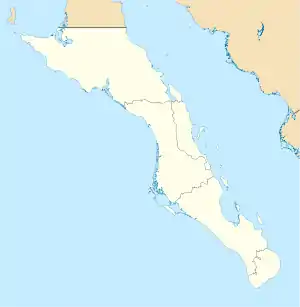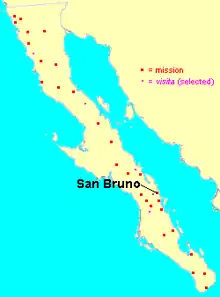Misión San Bruno
Mission San Bruno (Spanish: Misión San Bruno) was a short-lived Spanish mission established by Jesuit order on October 7, 1684, in what is now the Loreto Municipality of Baja California Sur, Mexico. The mission was the first Spanish mission established on the Baja California Peninsula.
 Location in Baja California Sur  Location in Mexico | |
| Location | Loreto Municipality, Baja California Sur, Mexico |
|---|---|
| Coordinates | 26°13′57″N 111°23′53″W |
| Patron | Bruno of Cologne |
| Founding date | October 7, 1684 |
| Founding Order | Jesuits |
| Native tribe(s) Spanish name(s) | Cochimí |
Location
The ruins of the mission are located along the northern banks of an intermittent river as it flows into the Gulf of California. The mission is unrelated to the present-day town of San Bruno, which is located 110 kilometres (68 mi) to the north of the mission.
Visita de San Juan Bautista Londó, a minor visiting chapel built in 1699, is located approximately 7.5 km (4.7 mi) to the east.
History

In 1683, the Spanish admiral Isidro de Atondo y Antillón and the Jesuit missionary Eusebio Francisco Kino were forced to abandon an attempted settlement and mission at La Paz because of hostilities with the native Pericúes and Guaycura.
In 1684, they moved north to the central portion of the peninsula, and selected a site for a settlement at the Cochimí settlement of Teupnon, near the mouth of a substantial arroyo about 25 kilometres (16 mi) north of the present day city of Loreto. The date was October 7, 1684, the Feast of San Bruno.[1]
Mission work was begun with about 400 local Cochimi Indians and exploratory expeditions into the surrounding region were undertaken, including the first land crossing of the Baja California Peninsula by Europeans. However, shortages of water and imported food supplies and problems of illness forced the abandonment of San Bruno in May 1685, leaving Baja California again entirely in native hands until the first permanent Jesuit mission was established at Misión de Nuestra Señora de Loreto Conchó in 1697.[2]
The San Bruno experience is documented in the letters and reports of Atondo, Kino, and other participants.[3]
Present day
A few crumbling walls of the uncompleted mission and fortress are all that remain of the San Bruno Mission.[4]
References
- Burckhalter, David, Sedgwick, Mina, and Fontana, Bernard L. (2013), Baja California Missions, Tucson: University of Arizona Press, p. 17; Bolton, 1936
- Burckhalter et al, p. 17
- (Bolton 1936; Burrus 1954, 1965; W. Michael Mathes 1969, 1974)
- Edward W. Vernon (2002:1-7)
Bibliography
- Bolton, Herbert Eugene. 1936. Rim of Christendom. Macmillan, New York.
- Burrus, Ernest J. 1954. Kino Reports to Headquarters: Correspondence of Eusebio F. Kino, S.J., from New Spain with Rome. Instituto Historicum S.J., Rome.
- Burrus, Ernest J. 1965. Kino Writes to the Duchess. Jesuit Historical Institute, Rome.
- Mathes, W. Michael. 1969. First from the Gulf to the Pacific: The Diary of the Kino-Atondo Peninsular Expedition, December 14, 1684 – January 13, 1685. Dawson's Book Shop, Los Angeles.
- Mathes, W. Michael. 1974. Californiana III: documentos para la historia de la transformación colonizadora de California, 1679–1686. José Porrúa Turanzas, Madrid.
- Vernon, Edward W. 2002. Las Misiones Antiguas: The Spanish Missions of Baja California, 1683–1855. Viejo Press, Santa Barbara, California.
See also
- Missions in Baja California Sur
- San Bruno, Baja California Sur
- Spanish missions in Baja California
- List of Jesuit sites